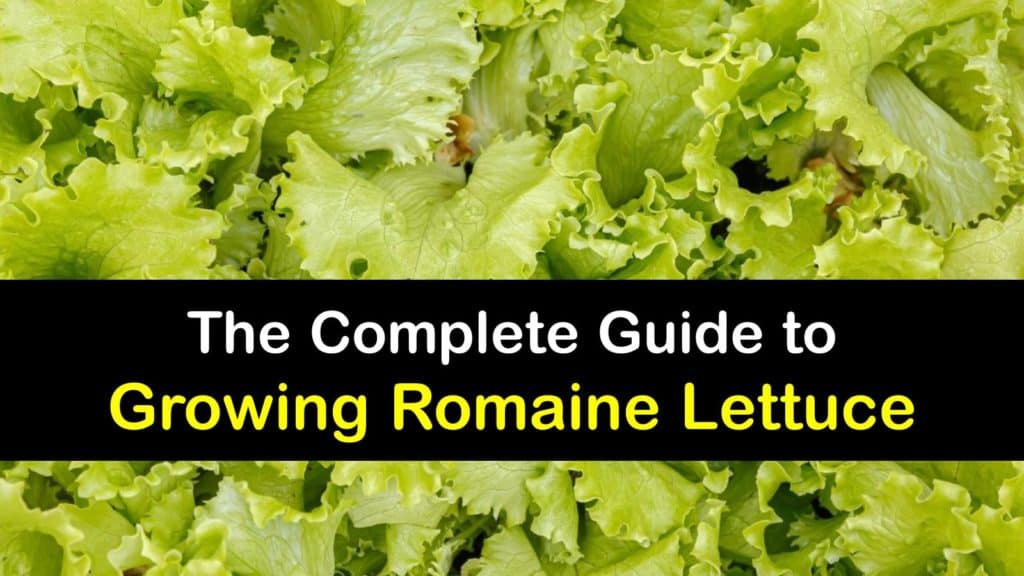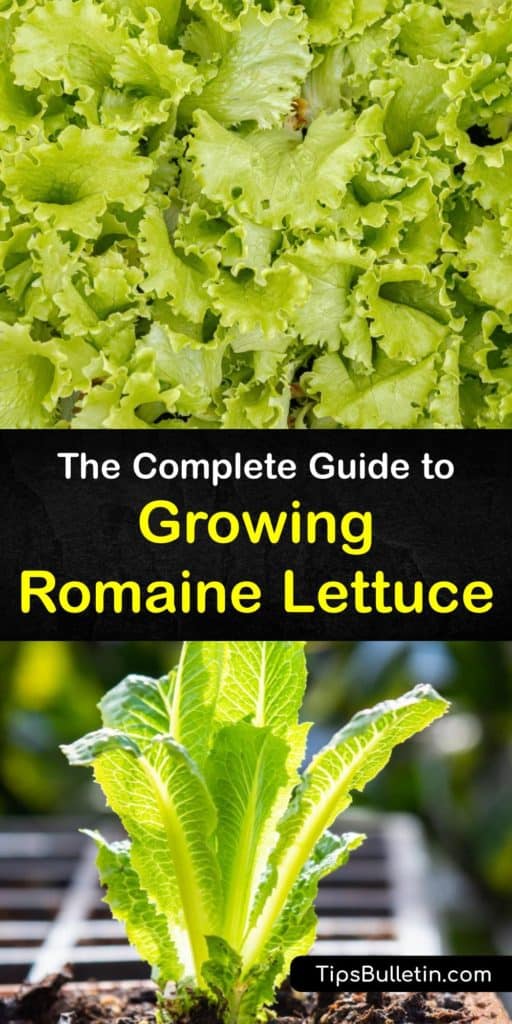Romaine lettuce is a fast-growing and rewarding crop to grow in the vegetable garden. It grows well just about anywhere, from raised beds to your kitchen windowsill. In this article, find out everything you need to know about how to grow romaine lettuce, from sowing seeds to enjoying the first of many harvests.
Since it is so fast-growing and adaptable, romaine lettuce is an ideal choice for a wide range of garden situations. All that’s required is cool weather, a location with full sun to partial shade, soil rich in nutrients and drains well, and plenty of water.
Some gardeners might be wondering, “How long does romaine lettuce take to grow?” With a relatively short growing season, romaine lettuce typically matures in 60-80 days. The best time to plant it is in early spring and late summer.

- Tips and Tricks for Growing Romaine Lettuce
- How to Grow Romaine Lettuce from Seeds
- Best Soil and Fertilizer for Romaine Lettuce Plants
- Growing Romaine Lettuce in Containers
- Optimal Growing Conditions for Lettuce Plants
- How Long does Romaine Lettuce Take to Grow?
- Harvesting and Storing Homegrown Romaine Lettuce
- Solutions for Common Pest and Disease Problems
Tips and Tricks for Growing Romaine Lettuce
Romaine lettuce develops a long, loosely formed head with firm ribs down the middle of the leaves. Although green leaves are the most common, there are also red leaf varieties of romaine lettuce.
The center, or heart, is a dense cluster of smaller leaves that are usually yellow or white. They taste sweeter and are more tender than the outer leaves.
In most northern regions, romaine lettuce is an ideal spring and fall crop. These cool-weather leafy greens flourish when temperatures are between 60-70℉ and withstand temperatures as low as 28℉.
They are exceptionally fast-growing, and baby greens are ready to pick within three or four weeks from planting lettuce seeds. Expect full-size heads in eight to ten weeks.
Learn the way to grow romaine lettuce from scraps to have a continuous harvest of these tasty greens. It’s easy to regrow lettuce in water no matter the variety.
Although romaine lettuce does fine in partial shade, it grows fastest in full sun with a minimum of six hours of direct sunlight throughout the day.
Whether growing romaine lettuce in containers or garden beds, provide loose, well-draining soil rich in nutrients and organic matter. Lettuce plants tend to be heavy feeders, so fertilize them four or five weeks after they sprout.
There are four principal types of lettuce: butterhead, crisphead, romaine, and looseleaf varieties.

Butterhead lettuce takes the longest to mature. Also called Boston or Bibb lettuce, it forms an attractive rosette of lightly ruffled leaves. These varieties tend to be more heat-tolerant than other cultivars.
Crisphead, or iceberg lettuce, forms a large, compacted round head of overlapping leaves. They have the mildest flavor and lowest nutritional content but are excellent for lettuce wraps and stir fry.
Looseleaf lettuce varieties usually grow fastest. They form open heads and have green, red, or speckled leaves.
Are you curious about where is romaine lettuce grown? Most of the commercially farmed romaine lettuce in the US comes from Arizona and California.
How to Grow Romaine Lettuce from Seeds
In most cases, it is best to sow romaine lettuce seeds directly in garden beds or pots. Plant seeds in early spring once the soil temperature is consistently above 40℉.
However, the optimal temperature for germinating lettuce seeds is 55-65℉. Germination normally takes seven to ten days.
Since lettuce seeds are so tiny, it is easiest to scatter them over the soil surface. Cover them with a quarter-inch layer of topsoil and compost, and then gently water them.
If you are planting in rows when you grow romaine lettuce from seed, the spacing between rows should be 12-18 inches. Once the romaine lettuce seedlings are an inch or two tall, thin them so the spacing between plants is six to eight inches.
Keep your garden soil moist at all times while the seeds germinate and as the seedlings develop. Grow lights are not usually necessary for growing romaine lettuce seeds indoors unless you do not have a sunny windowsill available.
If you started lettuce seedlings indoors or you purchased nursery-grown lettuce plants, the time for transplanting is around your region’s average last frost date.
Harden off romaine lettuce seedlings for about a week. Transplant lettuce seedlings outdoors by leaving them out in the elements for progressively longer stretches each day. The plants should be two to three inches tall and have at least four or five leaves before transplanting.
For a continuous supply of fresh romaine lettuce, try succession planting lettuce seeds every two or three weeks until the weather is consistently warmer than 80℉.
Plant lettuce seeds for a fall crop as soon as the weather starts cooling in late summer. In particularly dry or hot weather, lettuce plants cease leaf production and prematurely produce a seed stalk, a process called “bolting.”
Best Soil and Fertilizer for Romaine Lettuce Plants
Since romaine lettuce plants have a relatively shallow root system, it is crucial to grow them in loose, well-draining garden soil rich in organic matter.
A week or two before planting romaine lettuce seeds, work a generous layer of compost or well-rotted manure into your garden soil and ensure that the area is free from large rocks.
Plant fertilizer contains three essential macronutrients: nitrogen (N), phosphorus (P), and potassium (K). Nitrogen enhances leaf growth, phosphorus encourages robust roots, and potassium advances fruiting and flowering.
Leafy greens like lettuce benefit from regular applications of high-nitrogen fertilizer. Try making your own cost-effective DIY fertilizer with this high-nitrogen blend.
Blend the ingredients in a large bucket with a lid. Store it in a cool, dry place and apply it every three or four weeks throughout the growing season.
Growing Romaine Lettuce in Containers
Growing romaine lettuce in a container is a convenient way to easily access your fresh salad greens whenever you need them.
For the best results, use well-draining, nutrient-rich potting soil. Look for a potting mix containing extra perlite for drainage and coconut coir or peat moss for moisture retention.
Use a pot that is at least six inches deep and allow six to eight inches of space per lettuce plant. To avoid root rot and fungal disease, make sure the container has good drainage holes at the bottom.
It is even possible to regrow romaine lettuce from kitchen scraps. Cut a head of lettuce an inch or two above the base and place it in a shallow dish of water on your kitchen windowsill, or replant it in your veggie garden. A smaller set of lettuce leaves will grow within a few days.
Optimal Growing Conditions for Lettuce Plants
Have you ever wondered, “How does romaine lettuce grow?” These leafy greens are incredibly low-maintenance as long as you provide their preferred growing conditions.
Lettuce requires consistently moist soil, but it should not stay waterlogged for too long. Give your lettuce plants about one inch of water per week.
Drought stress often causes romaine lettuce plants to bolt and become bitter. Mulch with straw, leaf litter, grass clippings, or pine needles to retain moisture, minimize weed growth, and keep the soil temperature cooler.
How Long does Romaine Lettuce Take to Grow?
Have you ever wondered, “How long does romaine lettuce take to grow?” While it typically reaches maturity in 60-80 days, the exact harvest time depends on environmental conditions like air and soil temperature, daylight hours, and rainfall.
Romaine lettuce generally grows faster when planted in full sun. However, it may be slower to bolt in warmer climates if it gets a bit of afternoon shade from taller plants.
Harvesting and Storing Homegrown Romaine Lettuce
When to harvest romaine lettuce depends on your intended culinary use. For baby greens, snip the outer leaves when they are two or three inches long.
Harvesting your lettuce before the plant bolts is critical, as the leaves quickly become bitter and inedible. Many gardeners attest that lettuce leaves are the crispest and sweetest when picked early in the morning.
Harvest romaine lettuce by collecting the outer leaves as needed and allowing the new leaves to keep growing. Once fully mature, dig up the entire plant, or cut it an inch or so above the soil level to regrow a second, smaller head of lettuce.
Storing romaine lettuce the right way is important. Romaine lettuce stays fresh in the crisper drawer of the fridge for up to ten days. The way to store garden lettuce is to rinse and dry the leaves, and store romaine lettuce in a lidded container to reduce the risk of accidentally bruising the leaves.
In addition, keep lettuce away from fruits that generate large quantities of ethylene gas like apples, avocados, and pears. Ethylene gas is a naturally occurring chemical compound that accelerates the fruit ripening process and causes lettuce to wilt faster.
Solutions for Common Pest and Disease Problems
Although romaine lettuce is usually easy to grow, there are a few signs of pest and disease issues to watch for in the vegetable garden.
Your best line of defense is keeping the plants as healthy as possible by providing appropriate amounts of light, nutrients, and water, so they are more resistant to possible attacks from insects and pathogens.
Aphids, cutworms, leaf miners, and slugs are a few of the most prevalent pests that feed on lettuce plants. In addition to damaging the lettuce leaves, these insects may transport diseases like mosaic virus between plants.
Protect the seedlings with row covers in the springtime to prevent insects from laying eggs on the tender young plants.
Once you notice the first signs of a pest infestation, thoroughly spray all plant parts with an organic insecticide like neem oil or insecticidal soap. Mulch with eggshells to deter slugs.
Some frequent plant diseases for lettuces include bacterial leaf spot and powdery mildew. Treat affected plants with organic copper or sulfur fungicide.
Romaine lettuce is one of the easiest veggies to grow in the garden at home. There is nothing like having easy access to fresh produce that goes straight from your backyard to your salad bowl.
Homegrown veggies are always tastier and more nutritious than what you find at the grocery store. Go beyond the classic Caesar salad and use your romaine lettuce in wraps, soups, green smoothies, spring rolls, and more.

If you enjoyed learning about growing romaine lettuce, please share this article about how to grow romaine lettuce with your fellow gardening enthusiasts on Facebook and Pinterest.